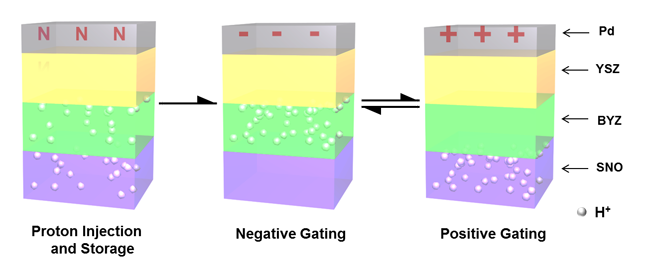Researchers from the University of Texas at Austin and Northwestern University have demonstrated a new method to improve the reliability and performance of transistors and circuits based on carbon nanotubes (CNT), a semiconductor material that has long been considered by scientists as one of the most promising successors to silicon for smaller, faster and cheaper electronic devices. The result appears in a new paper published in the journal Applied Physics Letters, from AIP Publishing.

These are optical images of individual SWCNT field-effect transistors.
Credit: S. Jang and A. Dodabalapur/University of Texas at Austin
In the paper, researchers examined the effect of a fluoropolymer coating called PVDF-TrFE on single-walled carbon nanotube (SWCNT) transistors and ring oscillator circuits, and demonstrated that these coatings can substantially improve the performance of single-walled carbon nanotube devices. PVDF-TrFE is also known by its long chemical name polyvinyledenedifluoride-tetrafluoroethylene.
“We attribute the improvements to the polar nature of PVDF-TrFE that mitigates the negative effect of impurities and defects on the performance of semiconductor single-walled carbon nanotubes,” said Ananth Dodabalapur, a professor in the Cockrell School of Engineering at UT Austin who led the research. “The use of [PVDF-TrFE] capping layers will be greatly beneficial to the adoption of single-walled carbon nanotube circuits in printed electronics and flexible display applications.”
The work was done in collaboration between Dodabalapur’s group at UT Austin and Mark Hersam’s group at Northwestern University as part of a Multi-University Research Initiative (MURI) supported by the Office of Naval Research.
A potential successor to silicon chips
Single-walled carbon nanotubes (SWCNT) are just about the thinnest tubes that can be wrought from nature. They are cylinders formed by rolling up a material known as graphene, which is a flat, single-atom-thick layer of carbon graphite. Most single-walled carbon nanotubes typically have a diameter close to 1 nanometer and can be twisted, flattened and bent into small circles or around sharp bends without breaking. These ultra-thin carbon filaments have high mobility, high transparency and electric conductivity, making them ideal for performing electronic tasks and making flexible electronic devices like thin film transistors, the on-off switches at the heart of digital electronic systems.
“Single-walled carbon nanotube field-effect transistors (FETs) have characteristics similar to polycrystalline silicon FETs, a thin film silicon transistor currently used to drive the pixels in organic light-emitting (OLED) displays,” said Mark Hersam, Dodabalapur’s coworker and a professor in the McCormick School of Engineering and Applied Science at Northwestern University. “But single-walled carbon nanotubes are more advantageous than polycrystalline silicon in that they are solution-processable or printable, which potentially could lower manufacturing costs.”
The mechanical flexibility of single-walled carbon nanotubes also should allow them to be incorporated into emerging applications such as flexible electronics and wearable electronics, he said.
For years, scientists have been experimenting with carbon nanotube devices as a successor to silicon devices, as silicon could soon meet its physical limit in delivering increasingly smaller, faster and cheaper electronic devices. Although circuits made with single-walled carbon nanotube are expected to be more energy-efficient than silicon ones in future, their drawbacks in field-effect transistors, such as high power dissipation and less stability, currently limit their applications in printed electronics, according to Dodabalapur.
A new technique to improve the performance of SWCNTs devices
To overcome the drawbacks of single-walled carbon nanotube field-effect transistors and improve their performance, the researchers deposited PVDF-TrFE on the top of self-fabricated single-walled carbon nanotube transistors by inkjet printing, a low-cost, solution based deposition process with good spatial resolution. The fluoropolymer coated film was then annealed or heated in air at 140 degrees Celsius for three minutes. Later, researchers observed the differences of device characteristics.
“We found substantial performance improvements with the fluoropolymer coated single-walled carbon nanotube both in device level and circuit level,” Dodabalapur noted.
On the device level, significant decreases occur in key parameters such as off-current magnitude, degree of hysteresis, variation in threshold voltage and bias stress degradation, which, Dodabalapur said, means a type of more energy-efficient, stable and uniform transistors with longer life time.
On the circuit level, since a transistor is the most basic component in digital circuits, the improved uniformity in device characteristics, plus the beneficial effects from individual transistors eventually result in improved performance of a five-stage complementary ring oscillator circuit, one of the simplest digital circuits.
“The oscillation frequency and amplitude [of the single-walled carbon nanotube ring oscillator circuit] has increased by 42 percent and 250 percent respectively,” said Dodabalapur. The parameters indicate a faster and better performing circuit with possibly reduced power consumption.
Dodabalapur and his coworkers attributed the improvements to the polar nature of PVDF-TrFE.
“Before single-walled carbon nanotube field-effect transistors were fabricated by inkjet printing, they were dispersed in an organic solvent to make a printable ink. After the fabrication process, there could be residual chemicals left [on the device], causing background impurity concentration,” Dodabalapur explained. “These impurities can act as charged defects that trap charge carriers in semiconductors and reduce carriers’ mobility, which eventually could deteriorate the performance of transistors.”
PVDF-TrFE is a polar molecule whose negative and positive charges are separated on different ends of the molecule, Dodabalapur said. The two charged ends form an electric bond, or dipole, in between. After the annealing process, the dipoles in PVDF-TrFE molecules uniformly adopt a stable orientation that tends to cancel the effects of the charged impurities in single-walled carbon nanotube field-effect transistors, which facilitated carrier flow in the semiconductor and improved device performance.
To confirm their hypothesis, Dodabalapur and his coworkers performed experiments comparing the effects of polar and non-polar vapors on single-walled carbon nanotube field-effect transistors. The results support their assumption.
The next step, Dodabalapur said, is to implement more complex circuits with single-walled carbon nanotube field-effect transistors.





